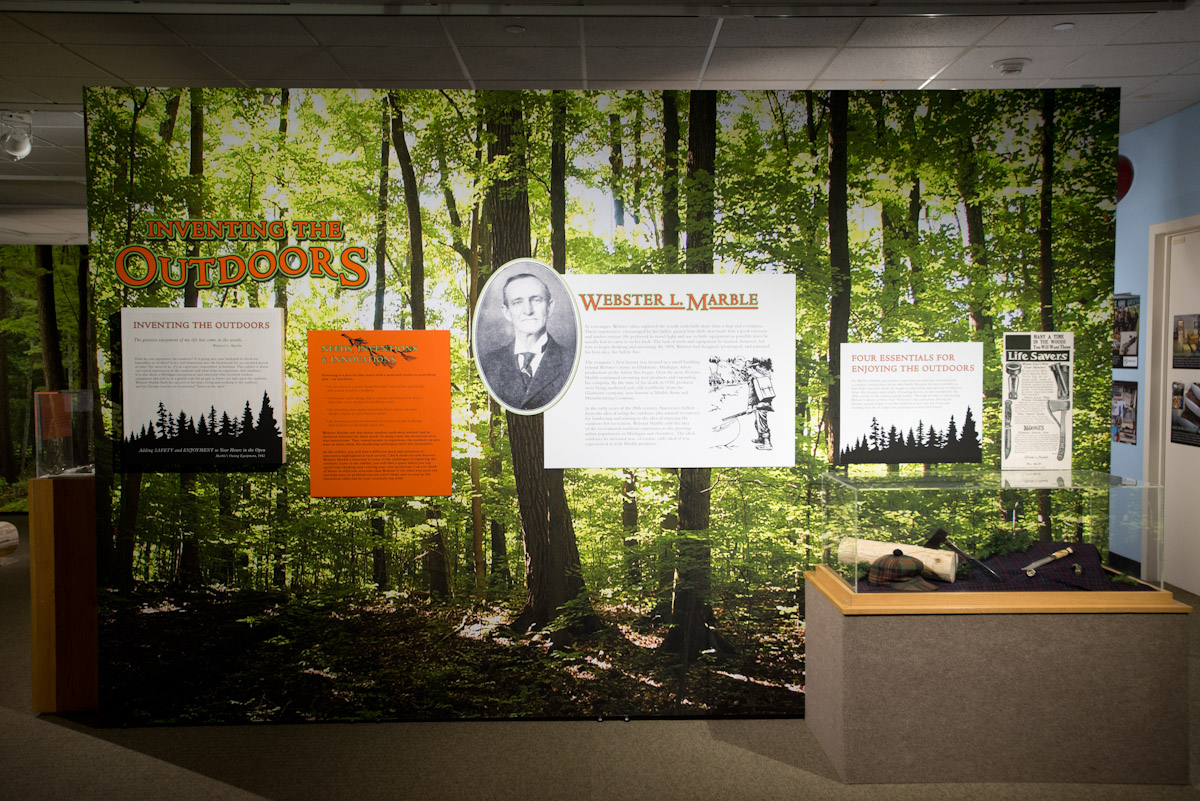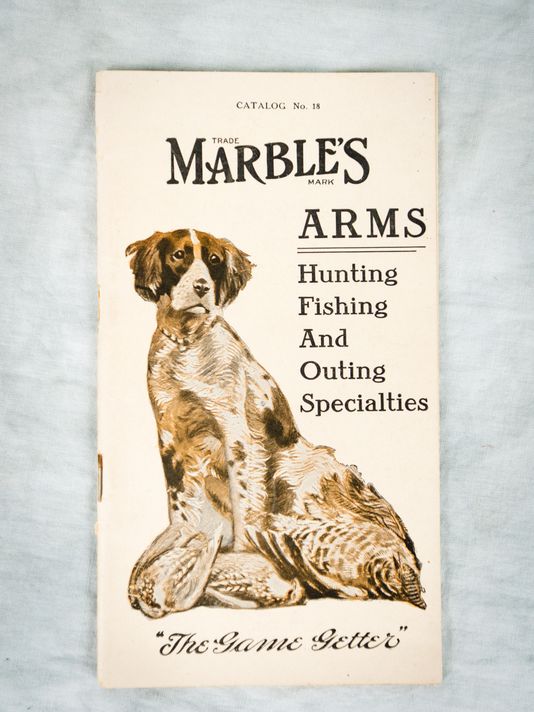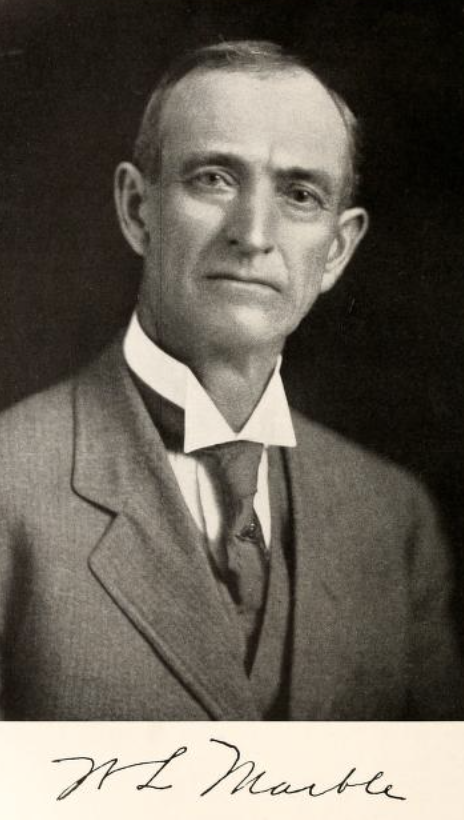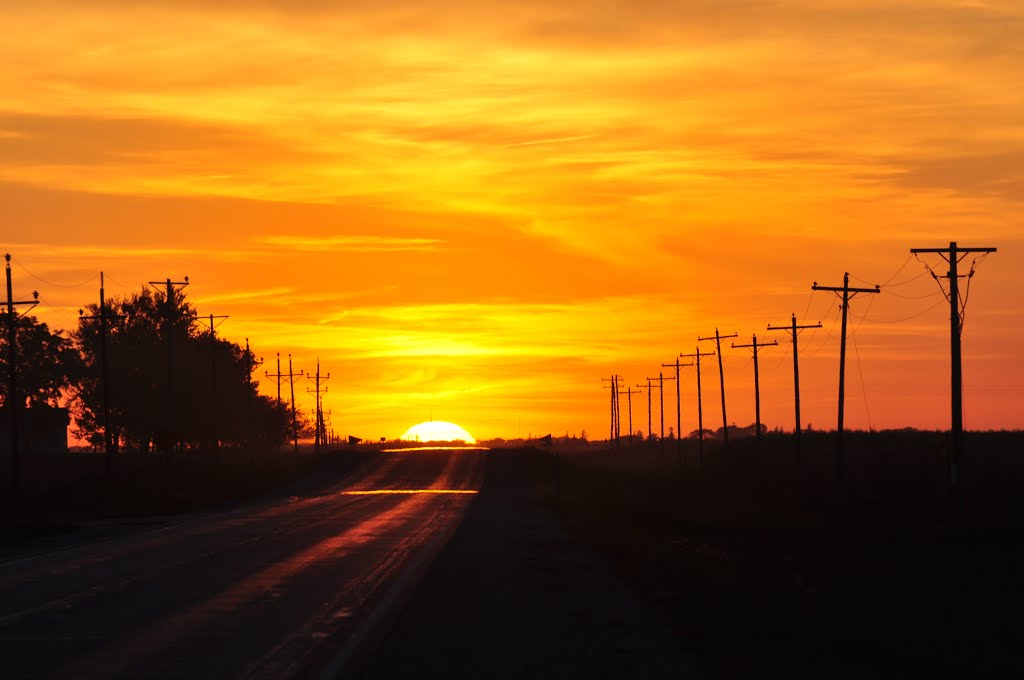
LANSING, Mi.—People can take the outdoors for granted.
As recent as the 1890s the “outdoors” was making the transition from a place where people foraged basic needs to a reflective place of recreation. The best thing about the outdoors?
You can’t take it with you.
Webster Lansing Marble knew this. Marble (1854-1930) is an overlooked outdoorsman and entrepreneur who carved out his niche in Gladstone, Mi. His Marble Arms & Manufacturing Company was the purveyor for Charles Lindbergh’s flights and Teddy Roosevelt’s hunting trips.
Marble is the focus of the wonderfully named “Inventing the Outdoors” exhibit that runs through Sept. 1 at the Michigan Historical Museum in downtown Lansing.
Retired Lansing advertising executive Dennis Pace is an enthusiastic Marble fan. In 2014 he donated his collection of nearly 400 pieces of Marble merchandise to the State of Michigan. Pace serves on the board of the Michigan History Foundation and is co-curator of the 250-piece exhibit that features Marble brainstorms like the safety axe, coat compass and waterproof match box that was invented in the early 1900s after Marble fell into the Sturgeon River in the Upper Peninsula.
Marble was definitely pre-Popeil.

“Without a doubt Webster Marble is the greatest outdoor inventor-entrepreneur that nobody has heard of,” the 66-year-old Pace said during an exhibit tour before I took in a Lansing Lugnuts Midwest League game earlier this month. “It is also a story that involves Chicago. If it wasn’t for Chicago, Webster Marble never would have had the job he had.”
Marble was born in Milwaukee. His father Lansing invented a bushel basket making machine among other things. Lansing sold the Milwaukee plant and moved to the wilderness of Vassar, Mi.
“Webster grew up to be a timber cruiser,” Pace said. “In his early twenties he was hired to work for the timber companies to harvest the forests of Michigan. That endeavor got speeded up in 1871 after the Great Chicago Fire. Chicago essentially placed an order for all the wood that Michigan could possibly ship to them. Webster spent 20 years in the woods working as a timber cruiser.”
A timber cruiser is part surveyor and part excavator.
Marble used as little equipment as possible since he usually had to carry it on his back. His desire for more convenient tools led him on the path to inventing. “Webster was about 5’2″ and not much over 100 pounds,” Pace said. “And he’s carrying 50 pounds on his back: surveying chains, a big surveying compass, a notebook.” The exhibit includes Marble’s detailed notebooks.
Webster’s great-grandson Joe McGonagle and his daughter Kathy opened up the family archives for the first time to explore Marble’s history. It took more than a year of research, design and construction to create the exhibit that spans 100 years.
By 1898 Marble designed, prototyped and patented his first idea of the safety axe. The company’s first factory was located behind Marble’s home in Gladstone, Mi. Gladstone is in the Upper Peninsula.

Marble was in the right place at the right time. About half of Michigan consists of water and has more shoreline than any other state except Alaska. Michigan is framed by four of the Great Lakes: Lake Superior, Lake Michigan, Lake Huron and Lake Erie.
“Webster had a foot in two worlds,” Pace explained. “He worked as a timber cruiser and until the mid-19th Century that was the method that Americans related to the outdoors. The outdoors were a treasure trove of natural resources. We mined the minerals, we harvested the timber and killed the bison for meat.
“Then, in the late 1800s more people came to cites like Detroit and Chicago. They were living in tenements and apartments with no air conditioning. They worked long hours. And they wanted to get outside. That was before the automobile so they would take the railroads up north where there were YMCA camps, hunting camps and outdoor camps.”
The outdoors were becoming a destination where visitors could improve their health and uplift their spirit. “People started looking at the outdoors as a place for recreation and not just for the exploitation of resources,” Pace said. “The Boy Scouts, Girl Scouts and Camp Fire Girls all start. Women start going into the woods.”
The Camp Fire Girls were born in 1912 as an offshoot of Cam WoHeLo near South Casco, Maine. “Part of that was to make women feel strong and independent and to get that good outdoor air which would physically and morally ‘refresh’ them,” Pace explained. “Then you have the first seasons for controlled hunting and fishing.”
People looked at the outdoors in a very different way.
And Marble could see the forest from the trees.
Last fall the State of Michigan passed a resoultion declaring every Nov. 15, the start of the state’s firearms deer-hunting season as Webster L. Marble Day.
“He spent 20 years as a timber cruiser,” Pace said. “He was going into the woods for weeks and months at a time. He went ahead of the timber companies who bought hundreds of thousands of acres or leased them. Webster surveyed section by section and drew little maps; ‘We’ve got 80,000 board feet of white pine another 25,000 board feet of red oak..’ That’s how timber companies worked. There weren’t a lot of good knives and axes specialized the way we know them, for lightweight camping. For example, Webster sketched how he could develop a compass that pinned to your coat. Then he realized the needle in the compass is hard to read in dim light so he invented the rotating dial, called the compass card. The whole dial rotates rather than the needle so it is easier to read.

“Webster starts to manufacture these new products in 1898 and ends up having 60 to 70 patents. He ends up with the largest factory of his kind–IN THE WORLD. He understands that if he is going to sell this stuff and make a lot of money, he’s not going to sell it to just timber cruisers and professional hunters. He’s going to sell it to all the people in the cities who want to get outside. Even if it is only for one weekend a year.”
Pace’s donated collection includes advertising materials, promotional pennants, catalogs and ‘The Marble’s Monthly Message,’ a magazine that featured columns like ‘Reminiscences of a Timber Cruiser.’ The exhibit includes Marble’s 1916 magazine reflection about a group of rugged lumbermen who were upended into chaos by a swarm of Yellowjackets.
Pace is an avid camper, hiker and mountain biker who loves the half a million acres of beaches and woods of the Huron-Mainistee National Forest in west central Michigan and the Porcupine Mountains in the Upper Peninsula. “The mountains are truly unique geologic features and some of the most silent land in the country to be alone in,” he said. Pace said Chicago visitors are at an all-time high in the Upper Peninsula.
People need to get away.
Pace discovered Marble’s work at a 1984 knife show. “I came across a couple tables filled with these beautiful products I had never seen,” he said. “They were all from the Marble Arms company. I met another collector and spent hours listening to his stories. I was hooked. This was a part of Michigan history and outdoors history I had never heard.”
Marble died on Sept. 22, 1930. “He was married later in his life,” Pace said. “After he came back from the woods.”
The advertising connection made Marble a kindred spirit for Pace, who called Marble one of the inventors of the celebrity endorsement in the outdoors product community. “When Teddy Roosevelt went to the Amazon and Africa, he was using all (Marble) outdoor products,” Pace said. “When Charles Lindbergh flew across the Atlantic for the first time, in his survival kit was a Marble compass, a Marble ideal knife and a Marble match safe to keep his matches dry. Those items are in the Smithsonian.” In the 1920s and 30s all Boy Scout and Girl Scout six-blade knives were Marble products.

“One of my favorite Marble quotes is that 90 per cent of knives and axes are bought by people who have no practical use for them,” Pace said with a laugh. “They want them as ornaments to display or merely possess. A picture from the 1920s or 30s is Marble’s typical customer, dreaming when they were in the military, great camaraderie in the woods, camping as a young man. These are pipe dreams.
“You’re not going to get out there that much. However, if you own a really great axe and nice knife you can take them out and look at them. It’s like restringing your fishing rod. Whether you use them or not, who knows?” “Inventing the Outdoors also includes a hands on ‘invention station’ where kids can learn and participate in the process of invention.
One exhibit panel features “Webster Marble’s 10 Lessons for Today’s Entrepreneurs.” Sadly, No. 10 is “Be Ready To Replace Yourself–In an evolving company be sure to know who can fill your shoes if interests or demands move your focus elsewhere.” Pace said, “He was a smart guy and a great entrepreneur but he broke one of the biggest rules of building a business—have somebody there to replace yourself.”
The Marble company still exists in Gladstone, but they only make iron gun sights. An odd company sidebar is the Hoegh Pet Casket Company in Gladstone. “Around 1966 Denny Hoegh comes from Iowa to Michigan,” Pace said. “He knows about plastic vacuum forming and starts making (plastic) gun cases. Marble sells these for a while and stops. There’s all this equipment, but what else can go in them? A light bulb goes off. ‘Dead pets!’ And now the Hoegh Pet Casket Company is the largest in the world.
The woodsy Webster Marble would be proud.
The bark is always louder than the blight.



